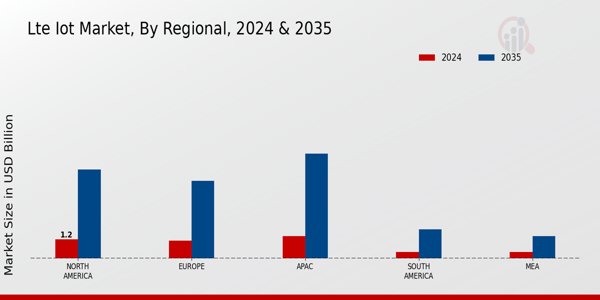Expansion of 5G Networks
The Global LTE IoT Market Industry is likely to benefit from the ongoing expansion of 5G networks. As telecommunications companies roll out 5G infrastructure, the capabilities of LTE IoT devices are expected to enhance significantly. This transition may lead to improved data transmission speeds and lower latency, which are crucial for applications such as autonomous vehicles and remote healthcare. The anticipated growth in 5G adoption could further stimulate the LTE IoT market, with a projected CAGR of 14.48% from 2025 to 2035. This evolution in network technology is expected to create new opportunities for IoT applications across various sectors.
Market Growth Projections
The Global LTE IoT Market Industry is projected to experience substantial growth in the coming years. With a valuation of 4.52 USD Billion in 2024, the market is expected to expand significantly, reaching an estimated 20 USD Billion by 2035. This growth trajectory suggests a robust compound annual growth rate (CAGR) of 14.48% from 2025 to 2035. Various factors, including advancements in technology, increasing demand for connectivity, and the proliferation of IoT applications across diverse sectors, are likely to drive this expansion. The market's evolution reflects the growing importance of LTE IoT in facilitating seamless communication and data exchange in an increasingly connected world.
Growing Demand for Smart Cities
The Global LTE IoT Market Industry is experiencing a surge in demand due to the increasing focus on smart city initiatives. Governments worldwide are investing in infrastructure that integrates IoT technologies to enhance urban living. For instance, cities are deploying smart traffic management systems and energy-efficient street lighting, which rely on LTE IoT connectivity. This trend is projected to contribute significantly to the market, with an estimated value of 4.52 USD Billion in 2024. As urban populations continue to rise, the need for efficient resource management and improved public services is likely to drive further adoption of LTE IoT solutions.
Rising Adoption of Wearable Devices
The Global LTE IoT Market Industry is witnessing a notable increase in the adoption of wearable devices, which rely on LTE IoT connectivity for data transmission. These devices, ranging from fitness trackers to health monitoring systems, are becoming integral to personal health management. The growing consumer interest in health and wellness is driving this trend, as individuals seek real-time insights into their health metrics. As the market for wearable technology expands, it is expected to contribute to the overall growth of the LTE IoT sector. The proliferation of such devices may also encourage further innovation in IoT applications, enhancing user experience and engagement.
Advancements in Industrial Automation
The Global LTE IoT Market Industry is poised for growth as industries increasingly adopt automation technologies. LTE IoT enables real-time monitoring and control of industrial processes, leading to enhanced efficiency and reduced operational costs. For example, manufacturers are utilizing LTE IoT for predictive maintenance, which minimizes downtime and extends equipment lifespan. This trend is expected to propel the market towards a valuation of 20 USD Billion by 2035. The integration of LTE IoT in industrial applications may also facilitate data-driven decision-making, thereby optimizing production processes and improving overall productivity.
Increased Focus on Environmental Sustainability
The Global LTE IoT Market Industry is increasingly influenced by the global emphasis on environmental sustainability. Organizations are leveraging LTE IoT technologies to monitor and manage resources more effectively, thereby reducing their carbon footprint. For instance, smart agriculture solutions utilize LTE IoT for precision farming, optimizing water usage and minimizing waste. This trend aligns with global sustainability goals and is likely to drive market growth as more businesses seek to adopt eco-friendly practices. The integration of LTE IoT in sustainability initiatives may also enhance compliance with regulatory standards, further supporting its adoption across industries.

























Leave a Comment